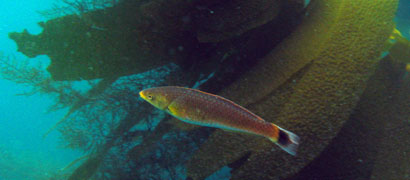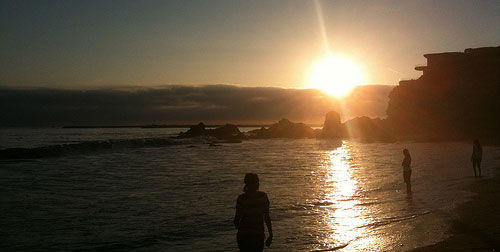
Kelp off Southern California was contaminated with short-lived radioisotopes a month after Japan's Fukushima accident, a sign that the spilled radiation reached the state's urban coastline, according to a new scientific study.
Scientists from California State University, Long Beach tested giant kelp collected in the ocean off Orange County and other locations after the March, 2011 accident, and detected radioactive iodine, which was released from the damaged nuclear reactor.
The largest concentration was about 250-fold higher than levels found in kelp before the accident.
"Basically we saw it in all the California kelp blades we sampled," said Steven Manley, a Cal State Long Beach biology professor who specializes in kelp.
The radioactivity had no known effects on the giant kelp, or on fish and other marine life, and it was undetectable a month later.
Iodine 131 "has an eight-day half life so it's pretty much all gone," Manley said. "But this shows what happens half a world away does effect what happens here. I don't think these levels are harmful but it's better if we don't have it at all."
A year ago, Manley watched coverage of the tsunami and Fukushima accident and wondered what impact it might have on California's marine life, particularly his favorite subject matter - kelp.
Spread in large, dense, brown forests across the ocean off California, Macrocystis pyrifera, known as giant kelp, is the largest of all algae and grows faster than virtually any other life on Earth. It accumulates iodine so Manley realized it would be a useful dosimeter to check how far radioactive material spreads.
"Kelp forests are some of the most productive ecosystems on Earth," he said. "I thought this would be an opportunity because one thing about macrocystis is it has a large surface canopy," which means it is continually exposed to the air - and whatever contaminants are in it.
In addition, giant kelp concentrates radioactive iodine 10,000-fold - for every one molecule in the water there would be 10,000 in its tissues.
Kelp was collected at three sites off Orange County, as well as Palos Verdes Peninsula in Los Angeles County, Santa Barbara, Pacific Grove and Santa Cruz. The highest concentration of iodine 131 was found in the kelp off Corona del Mar, which receives runoff from a large portion of Orange County. Its kelp was collected on April 15 of last year and tested five days later.

It was about 250 times higher than the concentration found in giant kelp off British Columbia before Fukushima.
When kelp from the same California sites was re-sampled a month later, in May of 2011, it contained no detectable amounts of radioactive iodine.
The scientists estimated that the entire kelp tissue on the surface at Corona del Mar contained about one millicurie.
"In terms of overall exposure to the kelp bed itself, it's not a huge amount," said Manley.
It would not have harmed the kelp, a species that grows from northern Baja to southeast Alaska, he said.
Some radioactive material probably accumulated in fish that eat the kelp - opaleye, halfmoon and senorita.
"If they were feeding on it, they definitely got dosed. We just don't know if it was harmful. It's probably not good for them. But no one knows," Manley said. "In the marine environment it was significant, but probably not harmful at the levels we detected it, except it may have affected certain fish's thyroid systems, the ones that fed on the kelp."
There is no published research on what iodine 131 might do to fish at the levels found in the kelp.
"That is a good question and one we don't really know the answer to as yet," said Christopher Lowe, a biology professor and director of Cal State Long Beach's Sharklab, which studies sharks and game fish. Lowe was co-author of the kelp study.
"Without actually measuring this, my guess is that the effects on fish thyroids from this limited exposure are probably negligible. However, that may not be the case for herbivorous fish species exposed closer to the release site" in Japan, Lowe said.
One toxicologist who works with fish said fish thyroids are sensitive to radioactive iodine but there is no data on its effects. High levels might cause thyroid tumors in the exposed fish or alter their cells' genetic material.
Although radioactive iodine would move up the food web, it would be decaying at the same time that it is being concentrated, so it would be gone from the fish within days.
"It's definitely not harmful to humans," Manley said.
Any effects on marine life would be "below minimal -- negligible, undetectable," said Nicholas Fisher, Distinguished Professor in the School of Marine and Atmospheric Sciences at State University of New York, Stony Brook.
"Do I think it's a public health concern? Absolutely not in California" and probably not in Japan marine life, either, Fisher said.
Iodine 131, found in nuclear fission products, is not naturally occurring and is not naturally found in oceans. It was a significant part of the plume from Fukushima, and a major contributor to the cancers and other health hazards from atomic bomb testing in the 1950s and the Chernobyl disaster.
The ocean and everything in it, however, contain many other naturally radioactive materials.
"The reality is there are far more natural radionuclides in marine life than manmade ones," Fisher said. "There are naturally occurring radioisotopes that have been in the ocean for billions of years, before man ever showed up and they occur at pretty high concentrations in organisms, much more than the artificial radioactivity introduced by Fukushima, or even Chernobyl, which was worse. Even at its peak, it was probably very low compared to the natural radionuclides."
Manley said that natural radiation in the ocean water is around 15 becquerel per liter. And if they calculated the levels in the water squeezed out of the kelp, "it would be 400 Bq per liter, which is well above the ocean average for natural radiation," he said. In the kelp itself, the amounts of Fukushima radioactivity were about the same as natural radioactive potassium found in other research.
The scientists only measured iodine 131, although other isotopes were in the plume from Japan that also accumulate in kelp. One of them, Cesium 137, has a 30-year half-life.
Fisher and chemist Ken Buesseler from Woods Hole Oceanographic Institution studied fish off the coast of Japan for Cesium 137 and 134, which accumulate in muscle tissues or filets. Their results are expected to be published next week.
Fisher said the levels they found in the fish 30 kilometers off Japan "are not a problem...Detectable, but not at high levels."
In Southern California, the kelp was collected after rainstorms, which would have washed the radioactive material from the air onto land and then into the ocean.
Other sites that were measured - including Orange County's Laguna Beach and Crystal Cove - were less contaminated than Corona del Mar, since the latter gets urban runoff via a creek that winds through much of Orange County.
"A whole confluence of things were happening. You've got this plume that moves along, and then when it rains, that's when the material comes out in the rain," Manley said.
Graduate student Danielle Burnett, who traces heavy metals in kelp, collected the macrocystis off Orange County for the radiation tests. Colleagues also sent Manley samples from Santa Barbara, Pacific Grove and Santa Cruz.
"We demonstrated the usefulness of using giant kelp as monitors for radioactive isotopes from nuclear accidents," Manley said.
Manley's idea is to get an organized group of people to grab kelp blades a few times a year to gather background values. Then if a radioactive event occurs, they would take samples daily and chart what happens and which coastlines are affected.
"One of the beauties of this is you don't need real fancy equipment," he said. "It's very simple to sample kelp blades and dry them in the oven and grind them up and put them in a tube and count [the isotopes.]"
U.S. Environmental Protection Agency officials in San Francisco and Washington, D.C. declined to comment on the report or whether they will consider monitoring kelp. The EPA measured air and milk on the West Coast after Fukushima and concluded that "radiation levels remained well below any level of public health concern."
Fisher cautioned that people get bigger doses from living in high altitudes, flying on airplanes and having x-rays.
"It's appropriate to be concerned about it and test for it and monitor -- and that's what we're doing," he said. "But irrational fear doesn't make sense. The main point is that there is a natural radiation background that marine organisms always have been exposed to."



Reader Comments